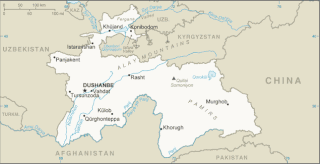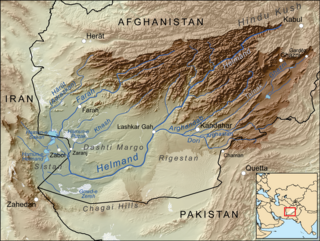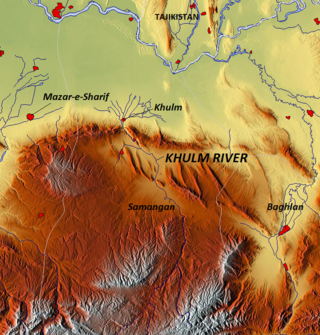


This is a list of rivers that flow wholly or partly in Afghanistan, arranged geographically by river basin.



This is a list of rivers that flow wholly or partly in Afghanistan, arranged geographically by river basin.





The Amu Darya is a major river in Central Asia and Afghanistan. Rising in the Pamir Mountains, north of the Hindu Kush, the Amu Darya is formed by the confluence of the Vakhsh and Panj rivers, in the Tigrovaya Balka Nature Reserve on the border between Afghanistan and Tajikistan, and flows from there north-westwards into the southern remnants of the Aral Sea. In its upper course, the river forms part of Afghanistan's northern border with Tajikistan, Uzbekistan, and Turkmenistan. In ancient history, the river was regarded as the boundary of Greater Iran with "Turan", which roughly corresponded to present-day Central Asia. The Amu Darya has a flow of about 70 cubic kilometres per year on average.

Tajikistan is nestled between Kyrgyzstan and Uzbekistan to the north and west, China to the east, and Afghanistan to the south. Mountains cover 93 percent of Tajikistan's surface area. The two principal ranges, the Pamir Mountains and the Alay Mountains, give rise to many glacier-fed streams and rivers, which have been used to irrigate farmlands since ancient times. Central Asia's other major mountain range, the Tian Shan, skirts northern Tajikistan. Mountainous terrain separates Tajikistan's two population centers, which are in the lowlands of the southern and northern sections of the country. Especially in areas of intensive agricultural and industrial activity, the Soviet Union's natural resource utilization policies left independent Tajikistan with a legacy of environmental problems.

The Syr Darya, historically known as the Jaxartes, is a river in Central Asia. The name, which is Persian, literally means Syr Sea or Syr River. It originates in the Tian Shan Mountains in Kyrgyzstan and eastern Uzbekistan and flows for 2,256.25 kilometres (1,401.97 mi) west and north-west through Uzbekistan and southern Kazakhstan to the northern remnants of the Aral Sea. It is the northern and eastern of the two main rivers in the endorheic basin of the Aral Sea, the other being the Amu Darya (Jayhun).

The Helmand River is the longest river in Afghanistan and the primary watershed for the endorheic Sistan Basin. It emerges in the Sanglakh Range of the Hindu Kush mountains in the northeastern part of Maidan Wardak Province, where it is separated from the watershed of the Kabul River by the Unai Pass. The Helmand feeds into the Hamun Lake on the border between Afghanistan and Iran.

The Kabul River, the classical Cophen, is a 700-kilometre-long (430 mi) river that emerges in the Sanglakh Range of the Hindu Kush mountains in the northeastern part of Maidan Wardak Province, Afghanistan. It is separated from the watershed of the Helmand River by the Unai Pass. The Kabul River empties into the Indus River near Attock, Pakistan. It is the main river in eastern Afghanistan and the Khyber Pakhtunkhwa province of Pakistan.
The Balkh River or Balkhab, also known in its upper reaches as the Band-e Amir River, is a river in northern Afghanistan.

The Panj, traditionally known as the Ochus River and also known as Pyandzh (derived from its Slavic word, is a tributary of the Amu Darya. The river is 921 kilometres long and has a basin area of 114,000 square kilometres. It forms a considerable part of the Afghanistan–Tajikistan border.

The Marghab River, anciently the Margiana, is an 850-kilometre (530 mi) long river in Central Asia. It rises in the Paropamisus Mountains in Ghor Province, flows through the Marghab District in central Afghanistan, then runs northwest towards the Bala Murghab. Reaching the oasis of Mary in the Karakum Desert of Turkmenistan, the Marghab debouches into the Karakum Canal, a diversion of water from the Amu Darya. The catchment area of the Marghab is estimated at 46,880 square kilometres (18,100 sq mi).

Lake Hāmūn, or the Hamoun Oasis, is a seasonal lake and wetlands in the endorheic Sīstān Basin in the Sistan region on the Afghanistan–Iran border. In Iran, it is also known as Hāmūn-e Helmand, Hāmūn-e Hīrmand, or Daryācheh-ye Sīstān.

The Sistan Basin is an inland endorheic basin encompassing large parts of southwestern Afghanistan and minor parts of southeastern Iran, one of the driest regions in the world and an area subjected to prolonged droughts. Its watershed is a system of rivers flowing from the highlands of Afghanistan into freshwater lakes and marshes and then to its ultimate destination: Afghanistan's saline Godzareh depression, part of the extensive Sistan terminal basin. The Helmand River drains the basin's largest watershed, fed mainly by snowmelt from the mountains of Hindu Kush, but other rivers contribute also.

Pseudoscaphirhynchus is a genus of relatively small, highly threatened sturgeons that are restricted to the Aral Sea system, including the Amu Darya and Syr Darya river basins, in Central Asia.

The dwarf sturgeon, little shovelnose sturgeon, or small Amu-Darya shovelnose sturgeon is a species of fish in the family Acipenseridae. It is found in Turkmenistan, Uzbekistan and probably in Tajikistan.

The Amu Darya sturgeon or false shovelnose sturgeon is a critically endangered species of fish in the family Acipenseridae. It is found in Turkmenistan, Uzbekistan, Tajikistan and perhaps Afghanistan. It inhabits quite shallow flowing waters that are turbid and muddy.
The Arghistan or Arghastan is a river in southern Afghanistan. It flows through Arghistan District and the provinces of Zabul and Kandahar. It is a tributary of the Dori River, a sub-tributary of the Helmand River. It flows for 280 kilometres (170 mi) and has a basin area of 20,219 square kilometres (7,807 sq mi).

The South Aral Sea was a lake in the basin of the former Aral Sea which formed in 1987 when that body divided in two, due to diversion of river inflow for agriculture. In 2003, the South Aral Sea itself split into eastern and western basins, the Eastern Sea and the West Aral Sea, connected by a narrow channel that balanced surface levels but did not allow mixing, and in 2005 the North Aral Sea was dammed to prevent the collapse of its fisheries, cutting off the only remaining inflow to the southern lakes. In 2008, the Eastern Sea split again, and in May 2009 had almost completely dried out, leaving only the small permanent Barsakelmes Lake between the Northern and Western Seas and increasing the expanse of the Aralkum desert. In 2010, it was partially filled again by meltwater, and by 2014 was once again dry. The West Aral Sea has some replenishment from groundwater in the northwest, and so is likely to avoid desiccation.

The Dori, also called the Lora and Kadanai, is a river of Afghanistan and Pakistan. It runs for 320 kilometres (200 mi) from Balochistan in Pakistan through Kandahar Province in Afghanistan, then flows into the Arghandab River.
The Kunduz River is a tributary of the Amu Darya in northern Afghanistan. It rises in Bamyan Province in the Hindu Kush, and in its upper reaches is also known as the Bamyan River or the Surkhab River. After passing through Baghlan Province and Kunduz Province, the Kunduz River merges into the Amu Darya.

The Khulm River is a river of north-central Afghanistan. In its lower course, it passes through Khulm and Haybak in Balkh Province. The Khulm is a tributary to the Oxus basin. Its source is south of the city of Khulm and it passes through the city of Samangan and Samangan Province. The Khulm River forms the western border of Kunduz Province.